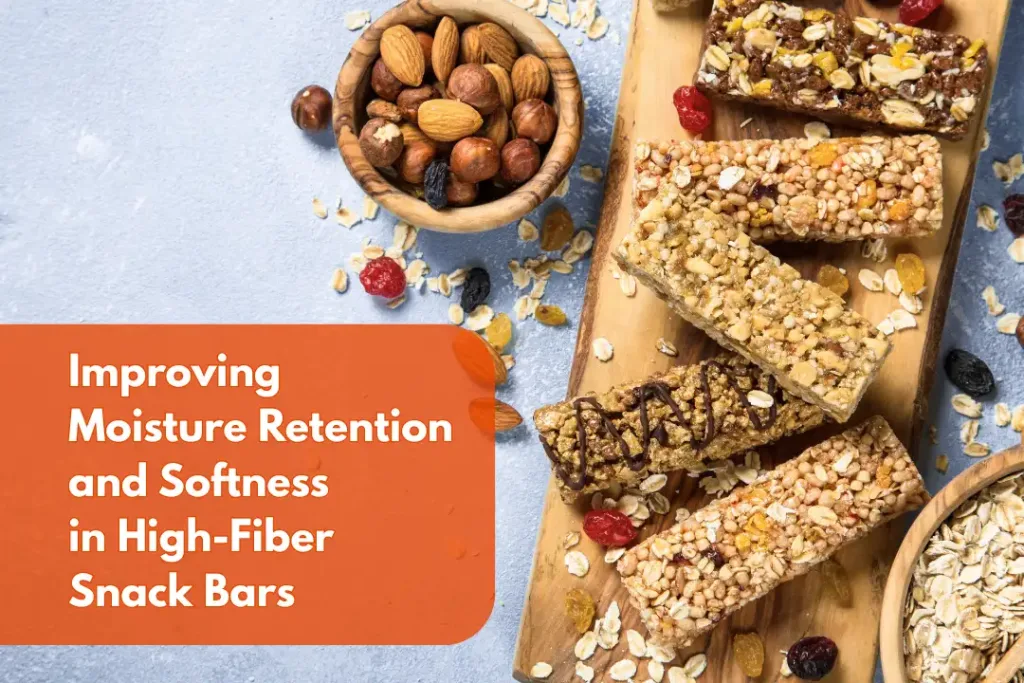Improving Moisture Retention and Softness in High-Fiber Snack Bars
May 28, 2025

The Texture Challenge in Fiber-Rich Snack Bars
How can manufacturers improve moisture retention and softness in high fiber snack bars without compromising label claims or eating experience?
As consumers seek healthier options, high-fiber snack bars have gained strong popularity. Yet, increasing fiber content often leads to challenges in product texture—such as dryness, crumbliness, or a tough bite. These textural issues become more pronounced during shelf life due to moisture loss and structural breakdown. Ensuring long-lasting softness and chewability in fiber-rich formulations has therefore become a key focus area for R&D and product developers.
This article explores how Digestive Resistant Dextrin (DRD) provides a unique solution by maintaining optimal moisture distribution, enhancing softness, and enabling clean-label claims in high-fiber snack bars.
Why Fiber Affects Moisture and Softness
Most traditional dietary fibers—such as oat bran, psyllium, or cellulose—are insoluble and bulk-forming. They tend to absorb or trap water in the matrix, which disrupts the balance of moisture in the bar. Over time, this water migration can lead to:
- Hardening or drying of the bar surface
- Crumbling upon cutting or consumption
- Reduced chewiness or increased toughness
These physical changes not only affect mouthfeel but also compromise the overall sensory appeal of the snack bar.
The Advantage of Digestive Resistant Dextrin in Snack Bar Formulation
Digestive Resistant Dextrin stands out as a fiber ingredient due to its functional properties:
- High solubility and low viscosity, enabling smooth integration into binding syrups
- Neutral taste, which preserves the flavor profile of the final product
- Heat stability, making it suitable for baked and non-baked snack bar processes
Unlike insoluble fibers, DRD contributes to total dietary fiber content without drying out the matrix or creating grittiness. It is also compatible with gluten-free, plant-based, or clean-label product formulations.
How DRD Enhances Water Binding and Texture Stability
One of the key mechanisms by which DRD improves moisture retention is its ability to bind water uniformly across the bar matrix. This prevents water from accumulating at the surface or migrating to low-density regions, which are common issues with other fiber types.
As a result, bars retain a moist, soft texture even under long-term storage. DRD’s water-holding capacity also reduces the risk of surface drying or hardening—critical for ensuring pleasant mouthfeel and consumer satisfaction.
Better Integration with Binding Syrups and Sweeteners
DRD works synergistically with typical bar binding systems, including:
- Polyols (e.g., sorbitol, maltitol)
- Glycerin
- Honey
- Glucose syrup
It enhances the viscosity and cohesiveness of these binders, leading to better dispersion and less phase separation. This integration reduces the likelihood of textural collapse or sticky surfaces, especially in snack bars that contain nuts, seeds, or granola clusters.
Synergy with Proteins and Fat Sources
In protein bars—especially those made with whey, soy, or pea protein—DRD supports structural integrity by evenly distributing hydration and minimizing brittle zones. Similarly, when used with fat-rich ingredients like peanut butter, almond paste, or coconut oil, DRD maintains a moist yet non-greasy consistency.
This synergy enables product developers to achieve a delicate balance between chew, softness, and shelf-life stability in diverse bar formulations.
Application Examples
Several practical applications demonstrate the effectiveness of DRD in snack bar production:
1. Weight Management Meal Bars
Formulations with DRD have shown sustained softness and moisture retention over 9 months of storage. These bars maintain their fiber content and satiety benefits while avoiding dryness.
2. Plant-Based Snack Bars
Bars using DRD in combination with natural ingredients like date paste and nut butter exhibit a pleasant, flexible bite and consistent moisture levels.
3. Granola Clusters and Fiber Bites
Even in low-moisture systems, DRD helps retain a satisfying crunch on the outside while preserving softness inside granola-style clusters.
Shelf-Life and Texture Preservation Strategies
To optimize the performance of DRD in snack bars, manufacturers should follow these best practices:
- Use DRD at 5–12% of total formulation weight, depending on target fiber claims and moisture profile
- Monitor water activity (aw) regularly to maintain safe and stable conditions (<0.6)
- Conduct accelerated shelf-life testing at 3-, 6-, and 9-month intervals to validate softness and structural consistency
- Select barrier packaging films with low oxygen and moisture permeability to preserve internal hydration levels
Clean Label and Functional Claim Support
One of the most compelling reasons to use DRD is its alignment with clean label trends. It allows for the following claims:
- “High Fiber“
- “Supports Digestive Health“
- “No Artificial Preservatives“
Moreover, DRD supports reduced sugar or reduced calorie positioning when replacing polyols or bulk sweeteners. This makes it highly attractive for health-conscious and label-savvy consumers.
Common Mistakes to Avoid
- Overuse of insoluble fibers without moisture control, leading to dryness
- Poor binder formulation, causing phase separation or clumping
- Inadequate hydration validation, which can result in inconsistent softness across batches
Avoiding these pitfalls requires a functional understanding of how DRD behaves in various systems and how to pair it with the right complementary ingredients.
Frequently Asked Questions
Is Digestive Resistant Dextrin suitable for gluten-free products?
Yes, DRD is gluten-free and can be used in certified gluten-free snack bars to enhance fiber content and texture.
Does DRD affect the flavor of the bar?
No, DRD has a neutral taste and does not alter the intended flavor profile of the product.
Can DRD be used in baked snack bars?
Yes, DRD is heat stable and retains its functional and nutritional properties during baking.
Build Soft, Functional, and Long-Lasting Snack Bars
Improving moisture retention and softness in high fiber snack bars no longer has to be a trade-off. Digestive Resistant Dextrin offers a versatile and scientifically proven solution to enhance texture, maintain moisture, and extend shelf life—all while supporting clean label and nutritional claims.
To explore high-performance ingredients like DRD for your next formulation, visit Satoria Nutrisentials and discover our range of functional fibers tailored for modern food manufacturing.